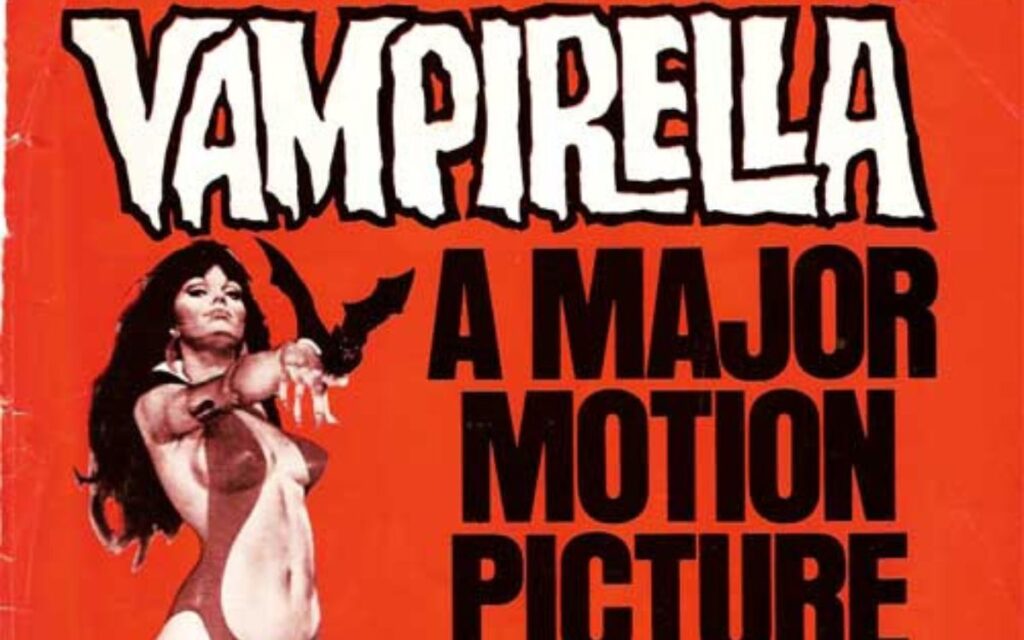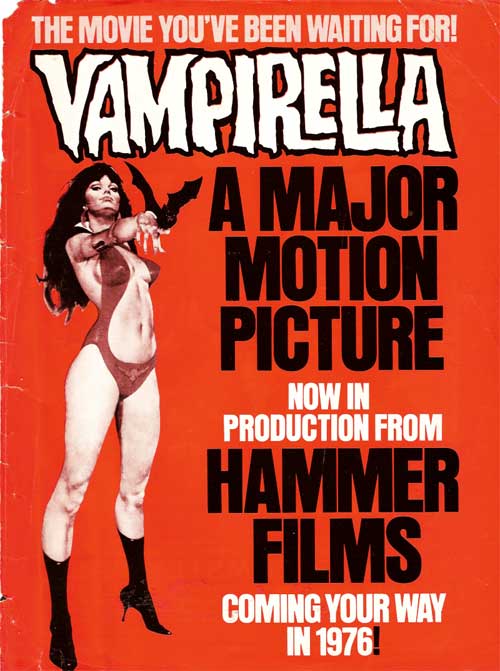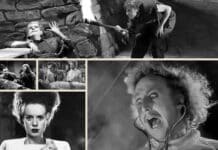BARRY McCANN ponders what might have been had Hammer followed through and produced these fabulous horrors

Read any book or visit a website on Hammer and, chances are, they will feature film posters for productions that never actually got made. Indeed, some of this artwork has become as iconic as the films that did make it to the screen, not to mention fuelling speculation as to what might have been. So here is a top ten of the great unmade Hammer classics… Thought there are a lot more besides, believe me!
1. The Revenge of Dracula (1959)
With the success of the 1958 Dracula, Hammer immediately commissioned a sequel script from Jimmy Sangster to star Christopher Lee, but without Peter Cushing’s Van Helsing.
Entitled The Revenge of Dracula, sources suggest it would have opened with the Count’s gypsy servants retrieving his ashes and restoring him with the blood of virgin maidens. With his gypsy army, Dracula sets about massacring villages he believes betrayed him. However, the sister of one of the slain virgins pursues her own revenge, and Dracula is killed when the spire of an ancient church topples and impales him.
How accurate this synopsis is remains unclear. However, it is fact that Lee was adamant about not playing the Count a second time (it would be another seven years before he relented), and a vampire tale with Van Helsing was conceived instead, resulting in Brides of Dracula (1960). So Cushing returned after all.
2. The Haunting of Toby Jugg (1969/1976)
Hammer originally planned to follow The Devil Rides Out (1968) with Dennis Wheatley’s tale of a war veteran haunted by a giant spider, and even prepared poster art suggesting Christopher Lee would star. However, the underperformance of the first Wheatley adaptation brought plans to film more of his stories to a halt.
Several years later, the success of The Exorcist and The Omen convinced Hammer to try again and an ambitious version of To the Devil, A Daughter resulted. The Haunting of Toby Jugg was announced as the follow, up along with a version of The Satanist, (with Orson Welles). Neither saw the light of day, as Wheatley was so incensed with Hammer’s derivative treatment of To the Devil, A Daughter, he withheld the rights to any more of his novels.
3. Zeppelin vs Pterodactyls (1970)
During the making of When Dinosaurs Ruled the Earth, one of the film’s stop motion animators, David Allen, submitted a storyline he called Raiders of the Stone Circle.
Proposed as dinosaurs meet the Saturday morning serials, it bore resemblance to Edgar Rice Burroughs’s The Land That Time Forgot, being set during World War One and surrounding a German Zeppelin blown off-course during a bombing raid, before winding up in a lost continent of prehistoric creatures. Hammer was interested and announced production as Zeppelin vs Pterodactyls.
However, they could not raise the finance for the required stop-motion animation and dropped it in favour of the dinosaur free prehistoric drama, Creatures the World Forgot.
Five years on, Amicus grabbed the consolation of filming The Land That Time Forgot (using puppet dinosaurs), while David Allen’s original title was later adapted into a similar type of adventure film by a certain Messrs. Lucas and Spielberg.
4. Victim of His Imagination (1972)
One of Hammer’s most intriguing near misses was a portmanteau surrounding the life story of Bram Stoker, interspersed with adaptations of his short stories such as The Squaw. An appearance by Christopher Lee as Dracula was also planned in a script initially drafted by Don Houghton, and developed by Chris Wicking and Michael Carreras. If the film had been made, it could have played Amicus at their own game. One for new Hammer, perhaps?
5. Dracula Walks the Night (1972)
As production completed on Dracula AD 1972, there were reports of an ambitious new entry proposed by Jimmy Sangster and Richard Matheson. It was to have opened with Dracula’s origins as Vlad the Impaler, then move forward to 1885 where Van Helsing joins forces with Sherlock Holmes to battle the vampire in the streets of London
With Terence Fisher set to direct, Lee and Cushing were to reprise their traditional roles, aided by Barbara Shelley as Drac’s vampire bride and Jack Palance as his servant, Macata. Sadly, Hammer could not raise the funds necessary for a film of this scale and opted for a second contemporary Dracula instead. At least Jack Palance got the consolation of playing the Count himself for a Dan Curtis TV movie in 1974.
6. Vampire Virgins (1973)
Planned as the fourth entry in the Karnstein series, the story concerned a pair of 19th century vampire killers, Johann and Kurt, who are hired by village elders to wipe out the undead at Karnstein Castle. When they return with 11 heads to claim 100 marks for each, the elders try to stall the pair. While Johann is prepared to be reasonable, Kurt kidnaps the elders’ daughters and holds them at Karnstein Castle for ransom. However, Count Karnstein is still alive and, turning the girls into vampires, sends them after the two hunters in revenge.
With a plot inspired by the Pied Piper, it was intended that Peter Cushing would take the part of Count Karnstein, making it his third appearance in the series playing a different role. However, this hat trick was not to be as Hammer shelved the project in favour of Captain Kronos Vampire Hunter.
7. The Insatiable Thirst of Dracula 1974
This was a treatment scripted by Anthony Hinds to follow 1973’s Satanic Rites of Dracula and, presumably, continue the contemporary timeline of the previous two films. With Christopher Lee refusing to play the Count again, and the opportunity of a horror/ martial arts co-production with Shaw Brothers in the offing, Hammer went with Legend of the Seven Golden Vampires instead.
A couple of years later, Insatiable Thirst of Dracula was dusted down for a proposed package of 13 feature length TV movies, intended to be shown on American television under the anthology title The Hammer House of Horror, and re-edited for theatrical release elsewhere. The series was intended as a co-production with Terra Filmkunst and filmed in Germany. However, Hammer failed to gauge commission from any of the American networks and the German company could not raise their part of the budget.
Whether Insatiable Thirst was seriously intended for the series, or included as an example for the initial proposal is not clear.
8. Vampirella (1975)

Based on the Warren Publications comic book, Hammer went to town on Vampirella with a screenplay by Jimmy Sangster, John Starr, Lew Davidson, and Christopher Wicking.
Peter Cushing’s Van Helsing was to have been brought into the screen story, while Caroline Munro and Valerie Leon were suggested for the lead. Neither were happy with the nudity required, so Hammer turned Barbara Leigh and had her visit American International Pictures in the Vampirella costume to gauge interest in co-financing the film. A mutually satisfactory deal could not be reached and the project simply evaporated.
9. Kali – Devil Bride of Dracula (1976)
Following The Legend of the Seven Golden Vampires, Warner Bros. suggested a follow up filmed in India and using a stock of rupees they had invested there. Kali – Devil Bride of Dracula was to back track to Van Helsing’s first encounter with Dracula in 19th century India, the vampire being in an unholy alliance with the goddess Kali, and all six of her arms.
The films would have repeated the Seven Golden Vampires formula with an abundance of swordplay action and an army of eyeless zombies. Peter Cushing was listed to return as Van Helsing, with a possible younger actor to replace John Forbes Robertson as Dracula.
Unfortunately, an economic downturn devalued the budget source and Hammer’s Dracula cycle came to an abrupt halt.
10. Nessie (1976)
“Will make Jaws look like a toothpaste commercial” was the promise made in 1976 when Hammer announced this ambitious co-production with Japan’s Toho studios. Bryan Forbes agreed to direct, in addition to working on the script, under the production team of David Frost, Euan Lloyd, Michael Carreras, and Tomoyuki Tanaka.
The film would have depicted the legendary creature leaving Loch Ness and going on an ocean wide rampage, destroying sea rigs and ships. Pre-production was ongoing for two years during which a Nessie prop was created by art director Yasuyuki Inoue. The collapse of Hammer finally brought Nessie to an end. She didn’t even get to meet Godzilla.
11. Vlad the Impaler (1978)
One April morning in 1974, Michael Carreras received phone calls from both his son, Jimmy, and Tony Keys saying “Did you hear that play?” They were referring to Brian Hayles’ Radio 4 drama, Lord Dracula, which proposed how the real life Vlad Tepes evolved into the blood sucking Count. Obtaining the screen rights from Hayles, Carreras announced the project as Vlad the Impaler and tried to interest both Richard Burton and Richard Harris to star. There was also speculation as to whether Christopher Lee might jump at the chance of playing Vlad himself, given his stated interest Dracula’s historic background.
The project floundered and was passed onto Carreras’ successors, Roy Skeggs and Brian Lawrence, who tried to revive it during the 1980s, but could not raise the backing. The central idea eventually formed the prologue of Francis Ford Coppola’s Dracula (1993), but not to the point of precluding a fuller film treatment. Maybe one day.







